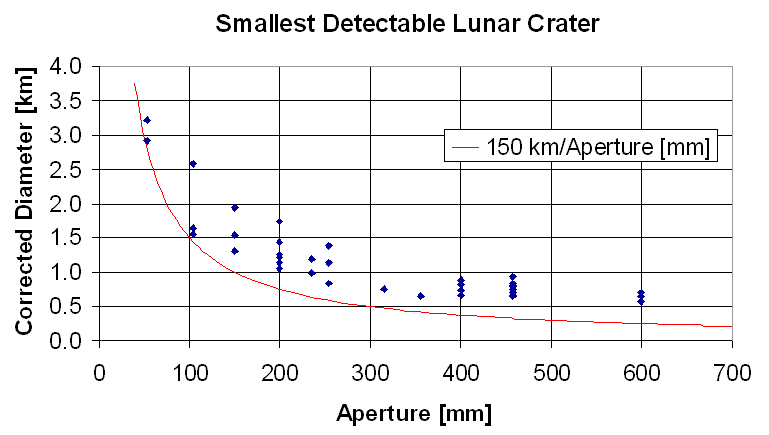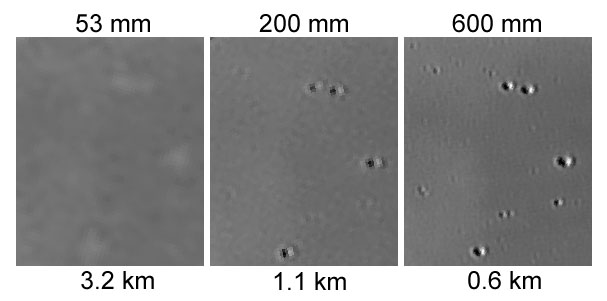January 20, 2018
Pushing the Envelope
Originally published July 28, 2008
Chart by Jim Mosher Please note that these numbers apply only to processed digital images. Visual observers cannot normally see this fine of detail.
Beginning amateurs are told that when it comes to telescopes, bigger is better. For planetary imaging this maxim is true, in part, because optical theory dictates that the intrinsic blurring of a point image is directly proportional to the wavelength and inversely proportional to the aperture. This chart is from a survey of 46 excellent recent amateur images of the Moon, and attempts to define the lower limit of crater visibility on each – the level at which the dark-light signature of craters merges with the background photographic noise. There is no good theory for where this limit should be, because it depends on many factors, including some psychological; but the data points at 53 mm show the threshold obtained by skilled amateur Bob Pilz using a blue filter on a high-quality refractor stopped to 2 inches, and the red line indicates the extrapolated envelope of results that should be achievable with larger scopes if the inverse aperture size principle held true. The actual results fall short of this by an increasing amount as one moves to the right. The largest amateur scopes, probably limited by seeing and perhaps by a less than optimal choice of bandpass, achieve less than half the linear resolution that might be possible. Will future photos push this experimental envelope still lower? Or is the empirical curve a fundamental limit imposed by the current technique of waiting for fleeting moments of stillness in a turbulent atmosphere? In either event, however short they may fall of perfection, it is truly remarkable that contemporary amateurs can reliably record sub-kilometer lunar details with telescopes as small as 10 inches -- something their predecessors only dreamed of!
Jim Mosher
The following images are representative of those used in the study, and show the central craterlets of Plato as seen with three apertures: left Bob Pilz -- the 3.2 km crater detection threshold is not quite adequate to convincingly portray even the largest of the craterlets, which are 2.1-2.5 km in diameter, but seen as vague smudges that could as easily be hills; center Bob Pilz -- an excellent result for an 8-inch Newtonian; right Bruno Daversin an exceptional result using a 24-inch Schmidt-Cassegrain. Note that the fine detail present in this last image was not entirely appreciated until it was reprocessed 3 years after its original capture. Is it possible there is envelope-pushing detail lurking in other older images?
Because there are many more small features than large per unit area on the Moon, even a small improvement in threshold can give rise to a major change in the amount of perceived detail.
Technical Details
- The web page from which the chart shown at the top is extracted includes a downloadable spreadsheet listing, and giving links to, each photo that was evaluated.
- The red line follows the formula indicated in the box. It might seem that moving the curve "up" would provide a better overall fit, but it is intended to represent the envelope of possibility. No matter where it starts, the larger aperture results will fall short of the 1/Aperture predictions.
- In the early 1950's, Ewen Whitaker proposed that for visual observations with small refractors the smallest detectable crater is about 0.72 of the telescope's Airy disk diameter. That figures to about 360 km/Aperture [mm], or slightly more than twice the limit proposed here for skillfully processed short-wavelength digital images.
- Further details for the three representative images shown at the bottom:
- 53 mm: Bob Pilz, April 17, 2008, 03:08 UT, with Custom Scientific blue filter
- 200 mm: Bob Pilz, July 7, 2007, 09:33 UT, with Custom Scientific blue filter
- 600 mm: Bruno Daversin, Sept. 17, 2003, 03:41 UT, bandpass unknown
- The three examples are cropped from a larger set of state-of-the-art amateur images of Plato's floor captured over the full range of apertures. Plato might seem rather far to the north for threshold measurements, but crater detection depends mostly on distinguishing the east-west shadowing, which is only slightly affected by foreshortening.
Related Links
Impossibly High Standard -- original presentation of Bruno's image
Yesterday's LPOD: Linears
Tomorrow's LPOD: Sunrise On an Unflat Plain
COMMENTS?
Register, Log in, and join in the comments.





